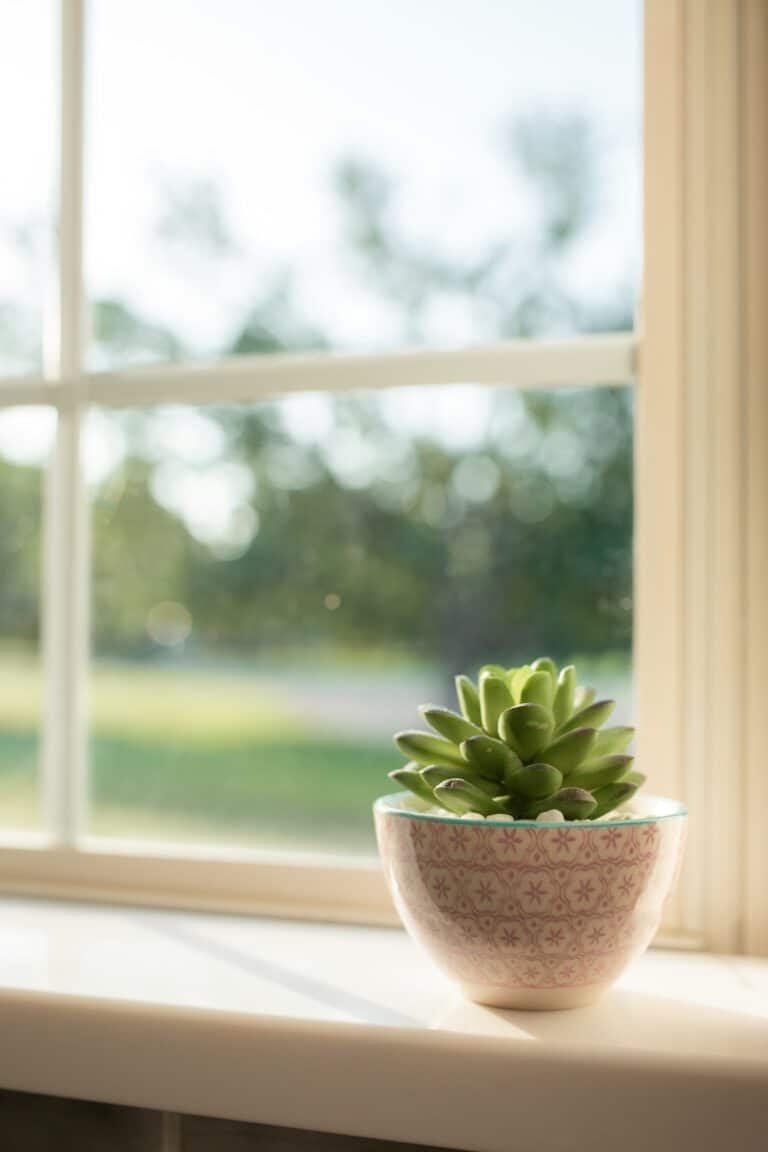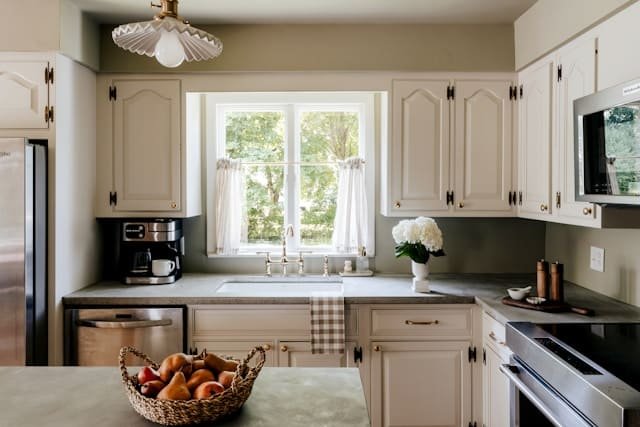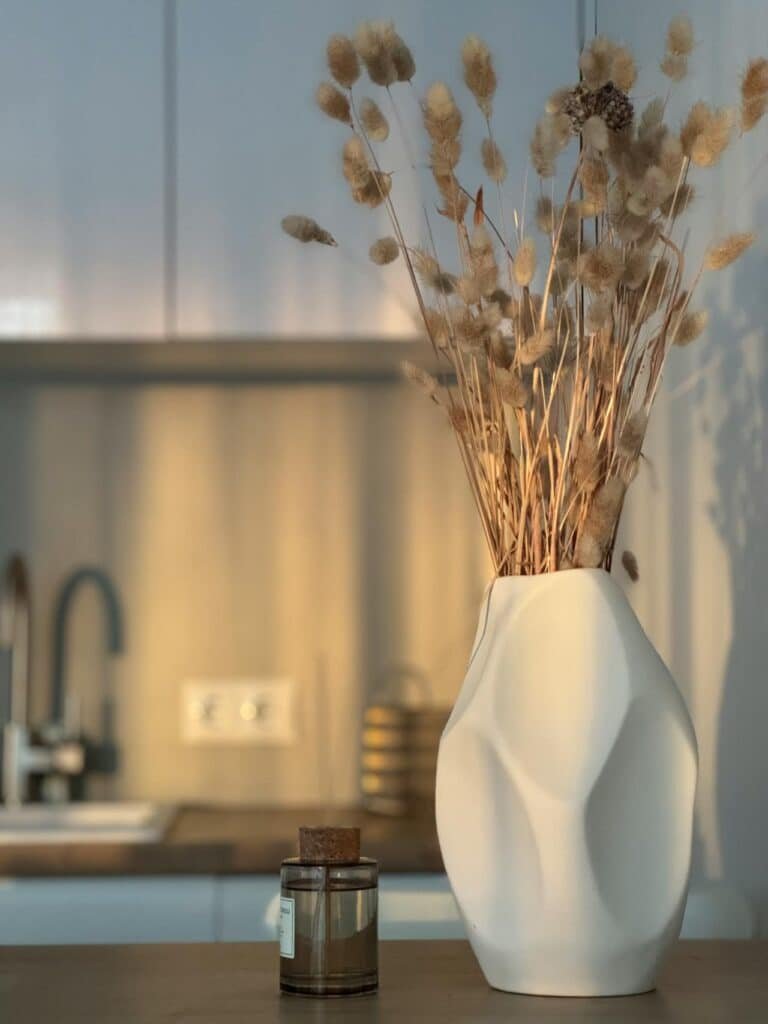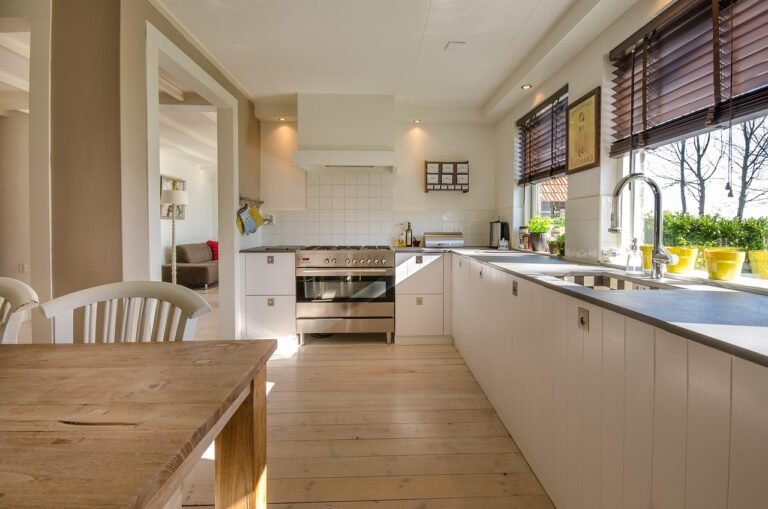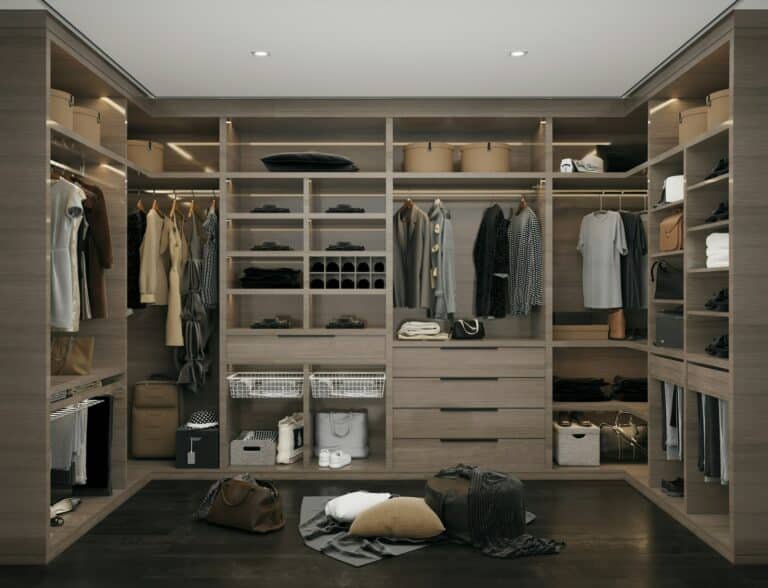20+ Beautiful Small Kitchen Color Ideas to Create a Bigger, Brighter Space

This post is about small kitchen color ideas.
When it comes to designing a small kitchen, color plays a crucial role. It defines the overall look, feel, and functionality of the space.
The right colors can make a compact kitchen feel more open, airy, and inviting. On the other hand, the wrong ones may make it appear cluttered and cramped.
Colors don’t just impact the size perception of a kitchen; they also influence mood and energy levels.
Since the kitchen is the heart of the home, where meals are prepared and families gather, choosing the right color scheme can create a warm and pleasant ambiance.
Light and reflective shades can make the kitchen look bigger and brighter. Bold or dark shades, when used strategically, can add depth and contrast.
In this post, I’ll share some brilliant small kitchen color ideas.
That includes paint colors, cabinet shades, appliance finishes, and accent color combinations that can transform your compact kitchen into a stylish and functional space.
Small kitchen color ideas
Check out these small kitchen color ideas that have the power to make even the tiniest kitchen bright, beautiful, and inviting!
Powder blue
Powder blue is a fantastic choice for a small kitchen. This soft, airy shade creates a cool and soothing ambiance, making the space feel more inviting and comfortable.
Not only does powder blue look beautiful, but it also has a light-reflective quality that helps open up the kitchen, making it feel brighter and more spacious.
Blush pink
If you love a feminine touch, opt for blush pink.
This delicate shade creates a warm and inviting atmosphere while keeping the room feeling light and open.
Blush pink pairs beautifully with other colors like sage, white, pale yellow, and soft gray, allowing you to create a stylish and cohesive color palette.
Pure white
Pure white is a classic and timeless choice for small kitchens. Its highly reflective quality helps bounce light around the room, making the space feel larger, cleaner, and more open.
Another great advantage of pure white is its versatility.
It pairs effortlessly with almost any accent color, allowing you to customize the look with pops of wood tones, metallics, pastels, or bold hues.
However, pure white can be hard to maintain, as every tiny spot, stain, or smudge will be noticeable.
If you choose this option, make sure you’re ready to keep up with regular cleaning to maintain its crisp and fresh appearance.
Warm white
Warm white is a soft, inviting shade with subtle hints of beige, cream, or yellow. It offers a more welcoming and comfortable feel compared to the crispness of pure white.
For a small kitchen, warm white works wonders! It keeps the space feeling bright and open while adding a touch of warmth and coziness. Unlike pure white, it feels softer and more lived-in, making your kitchen feel less sterile and more inviting.
This shade pairs beautifully with natural wood, brass, and soft pastels, creating a charming, homey atmosphere. Whether you love a modern farmhouse look or a minimalist style with warmth, warm white is a fantastic choice.
However, maintenance can be a challenge. Like pure white, it easily shows stains, grease, and smudges, so regular cleaning is a must to keep it looking fresh and pristine.
Ivory
Ivory is a warm, creamy shade of white with subtle yellow or beige undertones. It’s softer than pure white and warmer than warm white, making it the perfect middle ground for those who want a bright kitchen with a hint of coziness.
If pure white feels too stark and warm white feels too creamy, ivory is the sweet spot. It gives your small kitchen a light, airy feel while adding a touch of warmth and sophistication. The soft, muted tone makes the space feel elegant, inviting, and timeless.
Ivory pairs nicely with natural elements, for example, warm wood, rattan, and soft gold accents. It also works well with muted pastels, deep earthy tones, and even navy blue for a classic contrast.
It’s gentler on the eyes than bright white, hides dirt slightly better and adds warmth without looking yellowed or outdated. But, like all light colors, it still requires regular upkeep to maintain its fresh, clean look.
Pale beige
Pale beige is a warm, modern neutral that adds elegance without feeling too stark. Unlike white, it’s much easier to maintain, hiding stains and smudges better—perfect for a busy kitchen.
This shade feels sleek yet cozy, making it ideal for contemporary, minimalist, or farmhouse-style kitchens.
It also pairs beautifully with deep greens, charcoal grays, warm wood tones, and soft whites, creating a timeless, balanced look.
Greige
Greige is a sophisticated mix of gray and beige, offering the warmth of beige with the modern elegance of gray. It’s the perfect neutral shade for those who find gray too cool and beige too warm.
Unlike stark whites, greige is easier to maintain, as it hides stains and smudges well. It creates a modern, airy feel while adding subtle warmth, making a small kitchen look stylish yet inviting.
Greige pairs beautifully with crisp whites, deep blues, warm wood tones, and black accents, allowing for both soft, cozy palettes and bold, high-contrast designs.
Soft taupe
If you want a kitchen that feels warm but not too beige, modern but not too gray, soft taupe is the perfect choice.
Its mix of earthy brown and muted gray creates a subtle, sophisticated backdrop that works in any style—whether modern, rustic, or classic.
It’s comparatively easy to maintain. Unlike crisp whites, soft taupe hides smudges, fingerprints, and everyday messes, making it a practical pick for busy kitchens.
Mint green
Mint green brings a refreshing, light, and airy feel to a kitchen, unlike classic green, which can feel deeper and more intense.
While darker greens absorb most light and only reflect green tones, mint green reflects more light overall, making a small kitchen feel brighter and more open.
This soft, pastel shade adds a cheerful yet calming touch and works beautifully in both modern and vintage-style kitchens.
It creates a fresh, inviting atmosphere without overwhelming the space.
A stylish way to use mint green is to paint lower cabinets in this soft hue while keeping the upper cabinets a crisp white, warm cream, or soft gray for a balanced and elegant look.
Light oak
Light oak brings a soft, natural warmth to any kitchen, creating a cozy yet modern feel. Its subtle wood grain adds texture and depth without overwhelming the space.
This shade of wood reflects light well, making a kitchen feel open and airy while maintaining a natural, organic look.
It’s a great choice for those who love a clean yet inviting aesthetic.
For a balanced design, pair light oak with soft neutrals, earthy greens, matte black, or muted blues.
Soft yellow
You won’t see yellow in many kitchens, which makes it a unique and unexpected color choice.
While bold yellows can be too intense, a pale or muted yellow is soft, warm, and perfect for a small kitchen.
This gentle shade reflects light beautifully, making the space feel open and cheerful without being overwhelming. It adds a subtle glow that instantly makes the kitchen feel more inviting.
For a stylish and balanced look, pair soft yellow with light gray or soft sage green.
Peach
Peach is a rare yet beautiful choice for a small kitchen.
It has a gentle mix of orange and pink, creating a welcoming feel without being too bright.
This light shade helps reflect light, making a small kitchen feel more open and fresh. It brings a soft warmth that feels uplifting and pleasant.
For a beautiful and balanced look, pair peach with soft whites, warm beige, or light sage green.
Color Combination Ideas
Now, let’s explore some beautiful color pairings that can make a small kitchen feel brighter, more open, and full of personality!
Blush and white
Blush adds warmth and charm, while white keeps the kitchen light and airy. Together, they create a fresh, modern look that makes small spaces feel more open.
For a balanced design, consider blush cabinets with white countertops or white upper cabinets with blush lower cabinets. Add gold or brass accents for an extra touch of elegance!
Pale blue and light gray
Pale blue brings a soft, breezy feel, while light gray adds subtle depth without making the space feel dark. Together, they create a calming and sophisticated kitchen that feels open and inviting.
Light sage and white
Sage green has become a favorite in modern homes for its soft, natural feel. It brings a calm, refreshing touch without being too bold or overpowering.
When paired with crisp white, light sage looks effortlessly elegant and makes a small kitchen feel bright and open. The contrast keeps the space looking fresh, airy, and sophisticated.
All-white kitchens with texture variation
It’s not exactly a combination, but a great way to elevate an all-white kitchen!
An all-white kitchen can feel flat, but mixing textures—like matte cabinets, glossy tiles, and natural wood—adds depth and elegance.
Textured backsplashes, stone countertops, or woven accents keep the space bright while making it feel warm and inviting.
Neutral tones
Natural neutral shades bring a soft, effortless charm to a small kitchen. Earthy tones like sand, olive-tinted beige, and light wood create a space that feels grounded and welcoming.
Instead of overpowering the room, these colors blend seamlessly, making everything look harmonious and well-balanced.
Monochrome
A monochrome scheme means using different shades of the same color to create a cohesive, seamless look.
This approach works beautifully in a small kitchen because it eliminates visual clutter, making the space feel more open and expansive.
By layering lighter and darker tones within the same color family—like soft grays with charcoal accents or warm beiges with deeper taupe—you add subtle contrast without breaking the flow.
Accent Colors for Visual Interest
Light colors are ideal for small kitchens because they reflect light, making the space feel brighter and more open.
However, adding darker shades as accents—like deep gray cabinets, a navy backsplash, or black hardware—introduces contrast and depth, keeping the design from looking too plain.
Where to use accent colors:
Here are some great spots to use accent colors in a small kitchen:
- Backsplashes – A colorful backsplash adds character without overwhelming the space.
- Cabinet Interiors – A fun way to introduce color subtly, especially with glass-front cabinets.
- Islands – Painting the kitchen island in a contrasting shade makes it a stylish focal point.
- Decorative Accessories – Small touches like vases, dishes, or rugs bring in color effortlessly.
- Walls or Trim – A soft accent wall or painted trim can add charm without making the kitchen feel smaller.
- Open Shelving – Colored or stained shelves create contrast and visual interest.
Accent color ideas
Here are some beautiful accent colors to enhance your small kitchen:
Earthy terracotta
Earthy terracotta is a rich, warm shade inspired by natural clay, bringing a rustic yet elegant touch to any space. It works beautifully as an accent color in a small kitchen, adding depth and warmth without making the space feel heavy.
Light green
Adding green through accent walls, cabinets, or even potted plants is an easy way to introduce color while keeping the look natural and balanced.
Black
Black adds a sleek, modern touch to a small kitchen without overpowering the space.
Use it sparingly with black bar stools, window treatments, or appliances to create stylish contrast and sophistication.
Navy blue
Navy blue is a rich, visually appealing color that adds depth and elegance to a small kitchen. Use it for accent walls, lower cabinets, or bar stools to create a sophisticated and timeless look.
There are other ways to make your kitchen look bigger and brighter:
Apart from colors, there are many other ways to make your kitchen feel bigger and brighter. Smart lighting, reflective surfaces, open shelving, and minimal clutter can all create an airy, spacious feel. Even small changes, like choosing the right hardware or adding mirrors, can make a big difference.
Check out this blog post for more tips on making our small kitchen appear bigger and brighter.
20 Brilliant Tricks to Make Your Small Kitchen Look Bigger and Brighter
15+ Genius Small Kitchen Ideas on a Budget to Make It Look Big and Expensive
FIND OUT MORE SMALL KITCHEN IDEAS
- 10+ Small Kitchen Tools Under $30 That Will Transform Your Small Kitchen
- 20+ Incredibly Affordable Small Kitchen Organization Ideas When You Are on a Budget
- 10 Jaw-Dropping Modern Small Kitchen Ideas for a Minimalist Makeover
- 15+ Very Creative & Functional Small Kitchen Shelving Ideas You Need to Try Now!
- 15+ Genius Small Kitchen Ideas on a Budget to Make It Look Big and Expensive
- 20+ Stunning Small Kitchen Design Ideas to Maximize Style | Small Space, Big Style
- 10 Most Practical (& Brilliant) Small Kitchen Bar Ideas That Will Maximize Your Space!






















